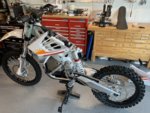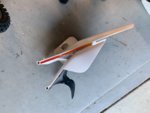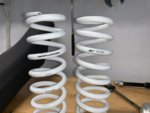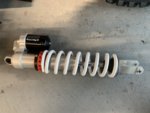C5tor
Chief Comedic Instigator
- Likes
- 1,739
- Location
- SF Bay Area, CA
This week’s project was updating suspension settings. I’ve been riding the MXR with stock settings since I got it a few months ago, to get used to it. I am not a very aggressive rider, and mostly do trails with my kids. But the stock settings are pretty harsh for trail riding. No questions here, just posting some pics and documenting my suspension changes, in case someone else in my weight (230) and riding style (trails/rocks, slow, small jumps) wanted a reference.
I backed off the air pressure a bit in the forks, and backed off the compression a bit as well, and that plushed things up quite a bit up front. At least it isn’t rattling my teeth out when going over washboards and braking bumps.
Also installed Motion Pro micro bleeders up front. Handy little devices!
The rear didn’t feel too bad stock, but the stock spring is a bit too weak to hold up my fat butt properly. I couldn’t get the sag anywhere near correct. Stock spring appears to be 60N/mm or 6.1kg/mm.
Picked up a 63/6.4 spring, and that allowed me to get in the 35mm/100mm ballpark for sag. Probably should have sprung for the 6.6, but I’m not planning on doing any big MX jumps in the near future. Plus, I’ve been losing a lot of weight lately (down 30+ lbs in the last 3 months) so planning on getting down to the 200-210 lbs range in the next few months. The 6.4 should work in the long run, I think.
Anyway, that was the project this week. I did note that the whole rear subframe, including fender, number plates, mudflap, etc., only weighs 8 lbs! Amazing!
Also, the shock adjustment is SO much easier on the Alta than on my old YZ426F. No carb or airbox or coil to get in the way of the shock adjuster ring. Just a nice empty space with nothing but shock occupying it. So much simpler!
Will have to see if the spring change helps on the next ride this weekend.





I backed off the air pressure a bit in the forks, and backed off the compression a bit as well, and that plushed things up quite a bit up front. At least it isn’t rattling my teeth out when going over washboards and braking bumps.
Also installed Motion Pro micro bleeders up front. Handy little devices!
The rear didn’t feel too bad stock, but the stock spring is a bit too weak to hold up my fat butt properly. I couldn’t get the sag anywhere near correct. Stock spring appears to be 60N/mm or 6.1kg/mm.
Picked up a 63/6.4 spring, and that allowed me to get in the 35mm/100mm ballpark for sag. Probably should have sprung for the 6.6, but I’m not planning on doing any big MX jumps in the near future. Plus, I’ve been losing a lot of weight lately (down 30+ lbs in the last 3 months) so planning on getting down to the 200-210 lbs range in the next few months. The 6.4 should work in the long run, I think.
Anyway, that was the project this week. I did note that the whole rear subframe, including fender, number plates, mudflap, etc., only weighs 8 lbs! Amazing!
Also, the shock adjustment is SO much easier on the Alta than on my old YZ426F. No carb or airbox or coil to get in the way of the shock adjuster ring. Just a nice empty space with nothing but shock occupying it. So much simpler!
Will have to see if the spring change helps on the next ride this weekend.





